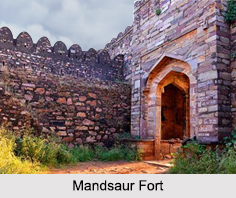 Mandsaur Fort, also known as "Dashpur Fort", is situated in the Mandsaur district of Madhya Pradesh. The fort was constructed in the 15th century and is a popular tourist destination in Mandsaur. This fort is known especially for its marvellous architecture. It was built by Hoshang Shah Ghori who was one of the first Islamic kings of the Malwa region. Mandsaur Fort was mainly associated with Mandu rulers.
Mandsaur Fort, also known as "Dashpur Fort", is situated in the Mandsaur district of Madhya Pradesh. The fort was constructed in the 15th century and is a popular tourist destination in Mandsaur. This fort is known especially for its marvellous architecture. It was built by Hoshang Shah Ghori who was one of the first Islamic kings of the Malwa region. Mandsaur Fort was mainly associated with Mandu rulers.
History of Mandsaur Fort
The Mandsaur city is situated on the border of Malwa and Mewar and as such was strategically very important. Dilawar Khan Ghori was governor of the Malwa province of central India during the decline of the Delhi Sultanate. He declared himself the "Sultan of Malwa" in 1401, and passed the kingdom to his son Hoshang Shah upon his death. Hoshang Shah Ghori (1405-1435) constructed the fort at strategically important Mandsaur city to strengthen his north-west boundary.
In 1519, Rana Sanga occupied the fort and appointed Ashokmal Rajput as its "Quiledar". In 1733, the Malwa Subedar of Mughals Sawai Jaisingh attacked the fort but was defeated by Marathas and the fort went to Marathas. The historically most important event in the fort was the treaty of 1818 between Tantiya Jog Senapati of Malhar Rao Holkar II and Sir John Malcum under which Malwa came in occupation of British rule.
Construction of Mandsaur Fort
Mandsaur Fort has 12 gates. It is surrounded by an outer wall. The south-east gate is known as "Nadi Darwaza". On the side of this gate is an inscription which reveals that it was constructed by an army officer Mukbil Khan in 1490 during the tenure of Ghiyas Shah (1469-1500).
Present Condition of Mandsaur Fort
Mandsaur Fort premises are nowadays used as office by Collector, District Judge and other Government Officers. There are two gardens in which there is a pillar of Surya Mandir. There is also a Shiva statue in the garden.
This article is a stub. You can enrich by adding more information to it. Send your Write Up to content@indianetzone.com.



















